简体中文
繁體中文
English
Pусский
日本語
ภาษาไทย
Tiếng Việt
Bahasa Indonesia
Español
हिन्दी
Filippiiniläinen
Français
Deutsch
Português
Türkçe
한국어
العربية
Order Types - WikiFX Forex Trading Concepts
Abstract:Understanding the various forex order types is an important aspect of any forex trading strategy. Orders enable you to specify a precise price target to purchase or sell at to begin or terminate a deal when that rate is met. They are an important component of risk management because they may be used to minimize risk or collect profit. Please keep in mind that placing dependent orders does not reduce your losses.

Orders are important instruments for every sort of trader and should always be considered while carrying out a trading plan. Orders may be used to get into a transaction, safeguard gains, and reduce negative risk.
Understanding the distinctions between the order types offered will help you identify which orders will best fit your requirements and help you achieve your trading objectives.
Market
A market order is the most basic order type and is executed at the best available price at the time the order is received.
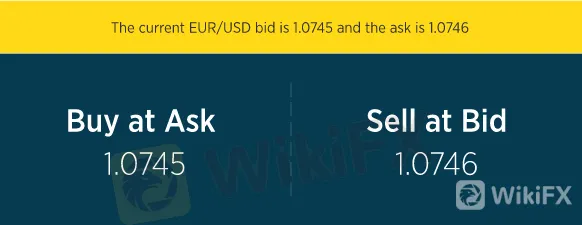
Limit
A limit order (sometimes known as a “take profit” order) is a buy or sell order that is placed at or above a certain price. A sell limit order is fulfilled at or above the specified price, while a purchase limit order is done at or below the specified price.

Limit orders allow you to be quite particular when selecting the entrance or exit point of a transaction. Limit orders do not ensure that you will join or exit a position since they are not executed if the specified price is not reached. A limit order tied to an existing open position (or a pending entry order) to close that position is also known as a “take profit” order.
Stop
When a preset rate is achieved, a stop order initiates a market order. When the offer price is reached, a buy stop order is activated, and when the bid price is met, a sell stop order is activated. Based on the available liquidity, both stop orders are executed at the best possible price. Stop orders often referred to as stop-loss orders, are frequently used to mitigate negative risk.
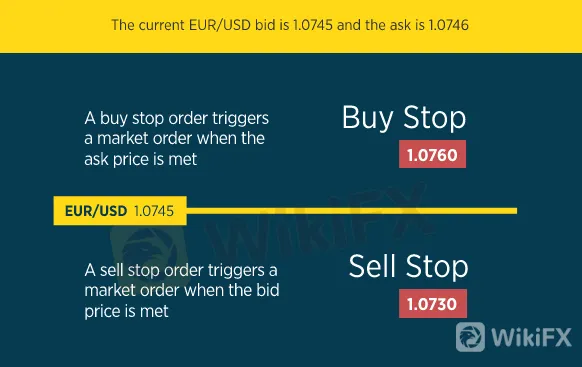
Stop orders aid in validating the market's direction before embarking on a transaction. It's vital to remember that when the market order is activated, stop orders are executed at the best attainable price based on existing liquidity.
Trailing Pause
A trailing stop order is set a specified number of pips away from the current market price. When the market moves in your favor, your trailing stop will automatically track your position.
If the market moves against you by a certain number of pips, a market order is triggered, and the stop order is executed at the next available liquidity-based rate.

Contingent orders
Contingent orders combine many kinds of orders and are used to implement a trading plan. Contingent orders need one of the commands to be activated before the other.
If/Then and If/Then OCO are the two most prevalent forms of dependent orders.
If/Then
If/then orders are a pair of orders with the condition that if the first order (the “if”) is executed, the second-order (the “then”) becomes an active, unrelated single order. Unassociated orders are not linked to a transaction and operate independently of position changes. If the “if” order fails to execute, the single “then” order is rendered inactive and will not be executed when the market reaches the appropriate rate. It is crucial to understand that if one side of an if/then the order is canceled, the whole order is canceled.
OCO if/then
If the first order (the “if”) is executed, the second-order (the “then”) becomes an active unassociated one-cancels-other (OCO) order. Unassociated orders are not associated with a transaction and operate independently of any position adjustments. The execution of any of the two “then” commands, like a standard OCO order, immediately cancels the other.
If the “if” single order fails to execute, the “then” OCO order will become dormant and will not be executed when the market reaches the required rate. If any component of an if/then OCO order is canceled (including either leg of the OCO order), the whole order is canceled.
Order Expirations
Market orders are considered day orders since they are executed at the lowest possible price. However, an expiry value of End of Day (EOD) or Good Till Cancel (GTC) may be set for all other order types.
End of Day - A purchase or sell order at a certain price will remain open until the end of the trading day, which is typically at 5 p.m. / 17:00 a.m. New York.
Good Until Cancelled - an order to purchase or sell at a certain price will stay open until filled or canceled. GTC orders at FOREX.com will expire on the Saturday following the 90th calendar day from the day they were submitted.
More WikiFX educational articles may be found at the following address: https://www.wikifx.com/en/education/education.html.


Disclaimer:
The views in this article only represent the author's personal views, and do not constitute investment advice on this platform. This platform does not guarantee the accuracy, completeness and timeliness of the information in the article, and will not be liable for any loss caused by the use of or reliance on the information in the article.
Read more
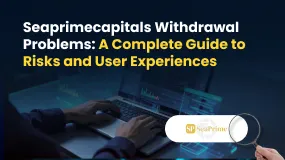
Seaprimecapitals Withdrawal Problems: A Complete Guide to Risks and User Experiences
Worries about Seaprimecapitals withdrawal problems and possible Seaprimecapitals withdrawal delay are important for any trader. Being able to get your money quickly and reliably is the foundation of trust between a trader and their broker. When questions come up about this basic process, it's important to look into what's causing them. This guide will tackle these concerns head-on, giving you a clear, fact-based look at Seaprimecapitals' withdrawal processes, user experiences, and trading conditions. Most importantly, we'll connect these real-world issues to the single most important factor behind them: whether the broker is properly regulated. Understanding this connection is key to figuring out the real risk to your capital and making a smart decision.

iFX Brokers Review: Do Traders Face Withdrawal Issues, Deposit Credit Failures & Free Coupon Mess?
Have you had to pay several fees at iFX Brokers? Had your trading profit been transferred to a scamming website, causing you losses? Failed to receive withdrawals from your iFX Brokers trading account? Has your deposit failed to reflect in your trading account? Got deceived in the name of a free coupon? Did the broker officials not help you in resolving your queries? Your problems resonate with many of your fellow traders at iFX Brokers. In this iFX Brokers review article, we have explained these problems and attached traders’ screenshots. Read on!
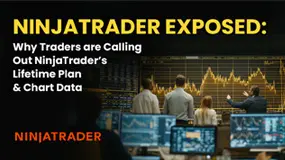
NinjaTrader Exposed: Why Traders are Calling Out NinjaTrader’s Lifetime Plan & Chart Data
Did NinjaTrader onboard you in the name of the Lifetime Plan, but its ordinary customer service left you in a poor trading state? Do you witness price chart-related discrepancies on the NinjaTrader app? Did you have to go through numerous identity and address proof checks for account approval? These problems occupy much of the NinjaTrader review online. In this article, we have discussed these through complaint screenshots. Take a look!
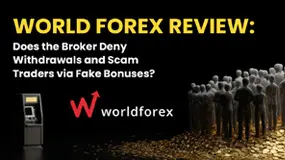
World Forex Review: Does the Broker Deny Withdrawals and Scam Traders via Fake Bonuses?
Does World Forex prove to be a not-so-happy trading experience for you? Do you struggle to withdraw your funds from the Saint Vincent and the Grenadines-based forex broker? Do you witness hassles depositing funds? Failing to leverage the World Forex no deposit bonus, as it turned out to be false? These accusations are grabbing everyone’s attention when reading the World Forex review online. In this article, we have shared some of these. Read on!
WikiFX Broker
Latest News
Axi Review: A Data-Driven Analysis for Experienced Traders
INZO Regulation and Risk Assessment: A Data-Driven Analysis for Traders
GGCC Bonus and Promotions: A Data-Driven Analysis for Experienced Traders
Close Up With WikiFX —— Take A Close Look At Amillex
CapEx Spending On AI Is Masking Economic Weakness
Questrade Review Pros, Cons and Regulation
AccentForex Review: Is It Safe to Invest or Scam?
Cleveland Fed's Hammack supports keeping rates around current 'barely restrictive' level
Delayed September report shows U.S. added 119,000 jobs, more than expected; unemployment rate at 4.4%
The CMIA Capital Partners Scam That Cost a Remisier Almost Half a Million
Currency Calculator



